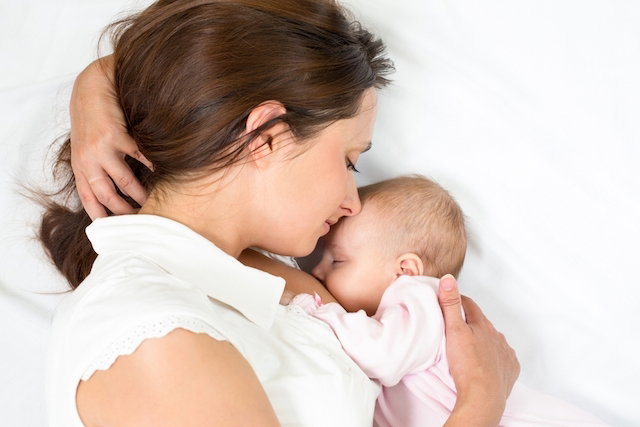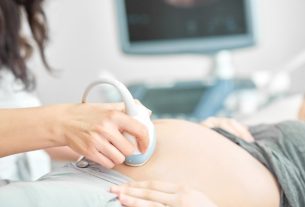The puerperium is the postpartum period that ranges from the day of birth until the return of the woman’s menstruation, after pregnancy, which can take up to 45 days, depending on how breastfeeding is done.
The postpartum period is divided into three stages:
- Immediate postpartum period: from the 1st to the 10th day postpartum;
- Late puerperium: dthe 11th to 42nd postpartum day;
- Remote postpartum period: from the 43rd day postpartum.
During the postpartum period, a woman goes through many hormonal, physical and emotional changes. During this period, it is normal for a type of “menstruation” to appear, which is in fact normal bleeding caused by childbirth, called lochia, which begins profusely, but gradually decreases. Understand better what lochia is and what care is important.

What changes in a woman’s body
During the postpartum period, the body goes through many other changes again, not only because the woman is no longer pregnant, but also because she needs to breastfeed the baby. Some of the most important changes include:
1. Harder breasts
The breasts, which during pregnancy were more malleable and without any discomfort, generally become harder because they are full of milk. If the woman is unable to breastfeed, the doctor may recommend a medicine to dry up the milk, and the baby will need to drink infant formula, as recommended by the pediatrician.
What to do: To alleviate the discomfort of full breasts, you can place a warm compress on your breasts and breastfeed every 3 hours or whenever the baby wants. Check out a complete breastfeeding guide for beginners.
2. Swollen belly
The abdomen still remains swollen due to the uterus not being at its normal size, which decreases every day, and becomes quite flaccid. Some women may also experience a separation of the abdominal wall muscles, a situation called abdominal diastasis, which must be corrected with some exercises. Understand better what abdominal diastasis is and how to treat it.
What to do: breastfeeding and using the abdominal belt help the uterus return to its normal size, and doing the correct abdominal exercises helps to strengthen the abdomen, combating sagging belly. See some exercises to do after giving birth and strengthen your abdomen in this video:
3. Appearance of vaginal bleeding
Secretions from the uterus come out little by little, which is why there is bleeding similar to menstruation, called lochia, which is more intense in the first few days but decreases each day, until it disappears completely.
What to do: It is recommended to use a larger intimate pad with greater absorption capacity, and always observe the odor and color of the blood, to quickly identify signs of infection such as: bad smell and bright red color for more than 4 days. If these symptoms are present, you should see a doctor as soon as possible.
4. Cramps
When breastfeeding, it is normal for a woman to feel cramps or some abdominal discomfort due to the contractions that return the uterus to its normal size and which are often stimulated by the breastfeeding process. The uterus shrinks by about 1 cm per day, so this discomfort should not last more than 20 days.
What to do: Placing a warm compress on the abdomen can bring more comfort while a woman breastfeeds. If it is bothering you a lot, the woman can remove the baby from the breast for a few minutes and then return to breastfeeding when the discomfort eases a little.
5. Discomfort in the intimate area
This type of discomfort is more common in women who had a natural birth with an episiotomy, which was closed with stitches. But every woman who has had a natural birth can experience changes in her vagina, which also becomes more dilated and swollen in the first few days after giving birth.
What to do: wash the area with soap and water up to 3 times a day, but do not take a sitz bath before 1 month. Normally the area heals quickly and within 2 weeks the discomfort should disappear completely.
6. Urinary incontinence
Incontinence is a relatively normal postpartum complication, especially if the woman had a natural birth, but it can also happen in cases of cesarean section. Incontinence can be felt as a sudden urge to urinate, which is difficult to control, with urine leaking into the panties.
What to do: Doing Kegel exercises is an excellent way to control your urine normally. See how these exercises against urinary incontinence are performed.
7. Return of menstruation
The return of menstruation depends on whether the woman breastfeeds or not. When breastfeeding exclusively, menstruation tends to return in approximately 6 months, but it is always recommended to use extra contraceptive methods to avoid getting pregnant during this period. If the woman does not breastfeed, menstruation returns in approximately 1 or 2 months.
What to do: check whether the bleeding after childbirth appears normal and start using the contraceptive method when the doctor or nurse indicates it. The day on which menstruation returns should be noted to indicate to the doctor at the next appointment. Know when to worry about postpartum bleeding.
Necessary care during the postpartum period
In the immediate postpartum period, it is important to get up and walk within the first few hours after birth to:
- Reduce the risk of thrombosis;
- Improve intestinal transit;
- Contribute to women’s well-being.
In addition, a woman should have an appointment with her obstetrician or gynecologist at 6 or 8 weeks after giving birth to check that the uterus is healing properly and there is no infection.
Bibliography
- MINISTRY OF HEALTH. Technical manual – Prenatal and postpartum care: qualified and humanized care. 2006. Available at: <http://bvsms.saude.gov.br/bvs/publicacoes/manual_pre_natal_puerperio_3ed.pdf>. Accessed on November 19, 2019
- Alia Macrina Heise. efore the Letdown: Dysphoric Milk Ejection Reflex and the Breastfeeding Mother . 2007.
- RAMÓN SARDÁ HOSPITAL. Normal and pathological puerperium. Clinical practice guide. 2021. Available at: <https://www.sarda.org.ar/images/Guia_de_practica_clinica_de_puerperio_normal_y_patologico.pdf>. Accessed on Jan 20, 2022
- ORDER OF NURSES. Use of a belt during the postpartum period . 2009. Available at: <https://www.ordemenfermeiros.pt/arquivo/documentos/Documents/Poder_CE-117-2009.pdf>. Accessed on 30 Jul 2021
- COSTA, Cyndi et al. Maternal and child nutritional care in the postpartum period. Science et Praxis. 11. 22; 23-29, 2018
- FREBASGO. Mastite puerperal. Available at: <https://www.febrasgo.org.br/pt/noticias/item/309-mastite-puerperal>. Accessed on April 21, 2021

Sign up for our newsletter and stay up to date with exclusive news
that can transform your routine!
Warning: Undefined array key "title" in /home/storelat/public_html/wp-content/plugins/link-whisper-premium/templates/frontend/related-posts.php on line 12
Warning: Undefined array key "title_tag" in /home/storelat/public_html/wp-content/plugins/link-whisper-premium/templates/frontend/related-posts.php on line 13





